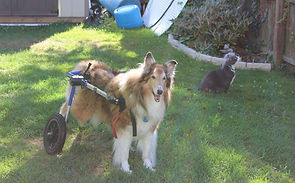Other Conditions that can present similarly to
Degenerative Myelopathy

At this time DM sadly cannot be a 'confirmed diagnosis' in a living dog, but many other conditions can have the same or similar symptoms and some of these other conditions can be treated successfully, or require different therapy to a dog with DM, to avoid further damage. It is therefore recommended if possible, to pursue as much testing as you can to 'Rule in or out' these other diseases and conditions.
If no other issue is confirmed to be causing the symptoms, you will be left with what is known as a 'Presumptive Diagnosis of DM'. Of course, not all owners are able to have all testing carried out due to many reasons, including; financial costs, the age of the dog and peoples own personal circumstances. If, however, you are unsure about it being DM, and the possibility of it being another issue, it is worth discussing this with your veterinarian in more detail. Professional vets are more than happy to work with you and consider other possible options and give details of the tests recommended.
Recommended Tests to help rule out other conditions:
-
A full Neurological examination
-
DM DNA test;
-
DM DNA test;
-
Blood tests, to include Lyme disease testing;
-
X-Rays;
-
MRI, and CSF analysis
A diagnosis of DM cannot be based on a single test alone........the way a dog is walking, flipping of the paw (also known as knuckling) an X-ray, blood work or a DNA test. To arrive at a 'Presumptive DM diagnosis', an examination by a board certified neurologist and an MRI is also needed. It is worth noting there is a difference between an Xray and MRI. Xrays produce flat images of the inside organs and bones of the body, is cheaper and quicker, but an MRI, although more costly, is able to take much more high resolution, clearer and detailed images than an Xray, particularly of soft tissue, tumors and most spinal issues. It is understandable, many people are not able to do all the testing outlined here for many different reasons, some mentioned above.
Just some of the other Diseases and Conditions
Peripheral nerve disease, Lumbral Sacral Stenosis, IVDD, "Discospondylitis, Spondylosis, Tick Diseases, Thyroid Problems, Cushings Disease, Wobblers, Polyradiculoneuropathy, Polymyositis, Granulomatous Meningoencephalomyelitis (GME) and spinal tumors are just a few diseases that can initially present similarly to DM. Below are more details of just a few conditions that are often mistaken for DM. One important rule to remember is if signs appear suddenly that you think are DM, then it is almost not DM. DM is a gradual onset, progressive disease.
IVDD, or Intervertabral Disc Disease is one of the most common diseases that can present like DM. In severe cases, demyelinization of the nerves can occur and the dogs can lose sensation. http://www.petwave.com/Dogs/Health/Intervertebral-Disk-Disease.aspx
Discospondylitis : Discospondylitis is infection of the intervertebral disc space.
https://todaysveterinarynurse.com/articles/discospondylitis-dogs-cats/
Lumbrosacral Stenosis (Cauda Equina): Degenerative lumbosacral stenosis is a common cause of cauda equina syndrome and
a relatively frequent neurologic disorder in older dogs. If this condition is recognized early, treatment may help alleviate significant morbidity. http://veterinarymedicine.dvm360.com/degenerative-lumbosacral-stenosis-dogs
Peripheral Neuropathy (Polyneuropathies): Polyneuropathy is a nerve disorder that affects multiple peripheral nerves. Unlike the central nervous system, which has the vertebrae of the spine, and the bone of the skull to protect it, the peripheral nerves are more exposed to the elements that enter into the body and come into contact with the body, so they are more susceptible to physical injury and toxic damage. http://www.petmd.com/dog/conditions/neurological/c_multi_peripheral_neuropathies#.T-dzLqEtHWw
Fibrotic Myopathy: Fibrotic Myopathy is thought to be an uncommon acquired, disorder which probably occurs to some degree after any muscle contusion that heals primarily by scar tissue. The whole muscle or part of the muscle is replaced with fibrous connective tissue within the semitendinosus and, occasionally, the quadriceps muscles of the hindleg. When most or all of the traumatized muscle is replaced by fibrous scar tissue that contracts to an inelastic band, it is termed fibrotic myopathy or muscle contracture.https://www.vetmed.wisc.edu/lab/corl/fibrotic-myopathy-study/

